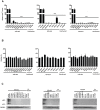Novel HIV-1 knockdown targets identified by an enriched kinases/phosphatases shRNA library using a long-term iterative screen in Jurkat T-cells
- PMID: 20174665
- PMCID: PMC2822867
- DOI: 10.1371/journal.pone.0009276
Novel HIV-1 knockdown targets identified by an enriched kinases/phosphatases shRNA library using a long-term iterative screen in Jurkat T-cells
Abstract
HIV-1 is a complex retrovirus that uses host machinery to promote its replication. Understanding cellular proteins involved in the multistep process of HIV-1 infection may result in the discovery of more adapted and effective therapeutic targets. Kinases and phosphatases are a druggable class of proteins critically involved in regulation of signal pathways of eukaryotic cells. Here, we focused on the discovery of kinases and phosphatases that are essential for HIV-1 replication but dispensable for cell viability. We performed an iterative screen in Jurkat T-cells with a short-hairpin-RNA (shRNA) library highly enriched for human kinases and phosphatases. We identified 14 new proteins essential for HIV-1 replication that do not affect cell viability. These proteins are described to be involved in MAPK, JNK and ERK pathways, vesicular traffic and DNA repair. Moreover, we show that the proteins under study are important in an early step of HIV-1 infection before viral integration, whereas some of them affect viral transcription/translation. This study brings new insights for the complex interplay of HIV-1/host cell and opens new possibilities for antiviral strategies.
Conflict of interest statement
Figures





Similar articles
-
A genome-wide short hairpin RNA screening of jurkat T-cells for human proteins contributing to productive HIV-1 replication.J Biol Chem. 2009 Jul 17;284(29):19463-73. doi: 10.1074/jbc.M109.010033. Epub 2009 May 20. J Biol Chem. 2009. PMID: 19460752 Free PMC article.
-
siRNA and shRNA screens advance key understanding of host factors required for HIV-1 replication.Retrovirology. 2009 Aug 27;6:78. doi: 10.1186/1742-4690-6-78. Retrovirology. 2009. PMID: 19712452 Free PMC article.
-
ZNRD1 (zinc ribbon domain-containing 1) is a host cellular factor that influences HIV-1 replication and disease progression.Clin Infect Dis. 2010 Apr 1;50(7):1022-32. doi: 10.1086/651114. Clin Infect Dis. 2010. PMID: 20192730
-
The role of Vif during HIV-1 infection: interaction with novel host cellular factors.J Clin Virol. 2003 Feb;26(2):143-52. doi: 10.1016/s1386-6532(02)00113-0. J Clin Virol. 2003. PMID: 12600646 Review.
-
Making Sense of Multifunctional Proteins: Human Immunodeficiency Virus Type 1 Accessory and Regulatory Proteins and Connections to Transcription.Annu Rev Virol. 2017 Sep 29;4(1):241-260. doi: 10.1146/annurev-virology-101416-041654. Annu Rev Virol. 2017. PMID: 28961413 Free PMC article. Review.
Cited by
-
Genome-wide screening using RNA interference to study host factors in viral replication and pathogenesis.Exp Biol Med (Maywood). 2011 Aug;236(8):962-7. doi: 10.1258/ebm.2010.010272. Epub 2011 Jul 4. Exp Biol Med (Maywood). 2011. PMID: 21727185 Free PMC article. Review.
-
Optimized PCR conditions and increased shRNA fold representation improve reproducibility of pooled shRNA screens.PLoS One. 2012;7(8):e42341. doi: 10.1371/journal.pone.0042341. Epub 2012 Aug 1. PLoS One. 2012. PMID: 22870320 Free PMC article.
-
A predictive model of immune infiltration and prognosis of head and neck squamous cell carcinoma based on cell adhesion-related genes: including molecular biological validation.Front Immunol. 2023 Aug 24;14:1190678. doi: 10.3389/fimmu.2023.1190678. eCollection 2023. Front Immunol. 2023. PMID: 37691922 Free PMC article.
-
JAK/STAT signaling pathway affects CCR5 expression in human CD4+ T cells.Sci Adv. 2024 Mar 22;10(12):eadl0368. doi: 10.1126/sciadv.adl0368. Epub 2024 Mar 20. Sci Adv. 2024. PMID: 38507500 Free PMC article.
-
Inhibition of HIV-1 transcription and replication by a newly identified cyclin T1 splice variant.J Biol Chem. 2013 May 17;288(20):14297-14309. doi: 10.1074/jbc.M112.438465. Epub 2013 Apr 8. J Biol Chem. 2013. PMID: 23569210 Free PMC article.
References
-
- Fauci AS. 25 years of HIV. Nature. 2008;453:289–290. - PubMed
-
- Flexner C. HIV drug development: the next 25 years. Nat Rev Drug Discov. 2007;6:959–966. - PubMed
-
- Stevenson M. Can HIV be cured? Sci Am. 2008;299:78–83. - PubMed
-
- Clavel F, Hance AJ. HIV drug resistance. N Engl J Med. 2004;350:1023–1035. - PubMed
-
- Greene WC, Peterlin BM. Charting HIV's remarkable voyage through the cell: Basic science as a passport to future therapy. Nat Med. 2002;8:673–680. - PubMed
Publication types
MeSH terms
Substances
LinkOut - more resources
Full Text Sources
Research Materials
Miscellaneous

